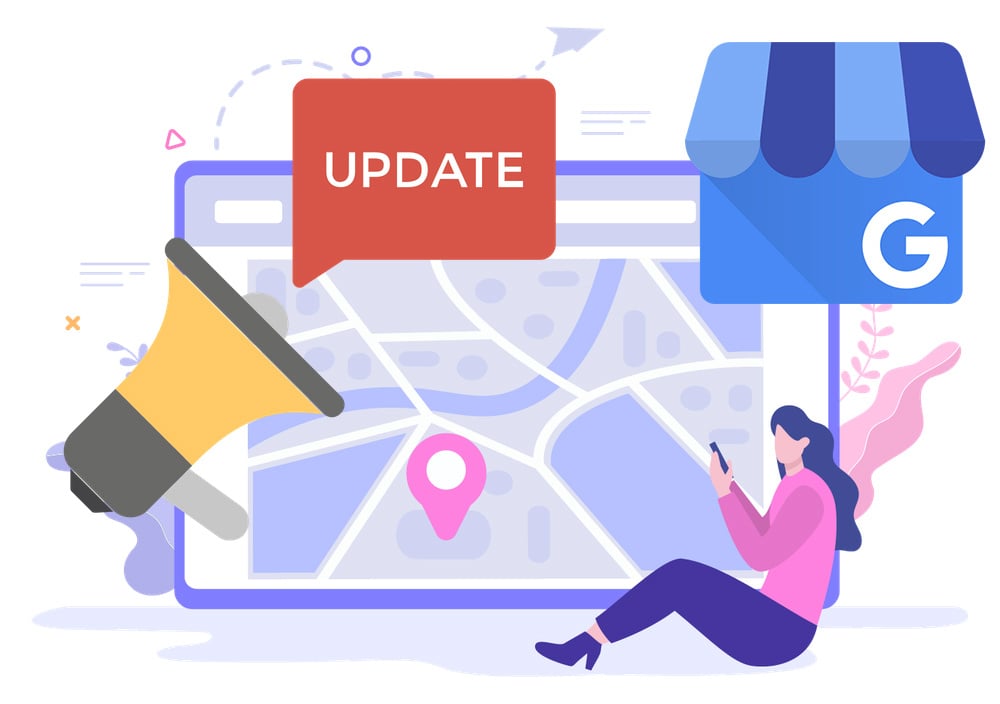How To Start a Moving Company
This detailed guide on how to start a moving business covers everything from forming a legal entity to hiring movers and more. Find out where to begin here.
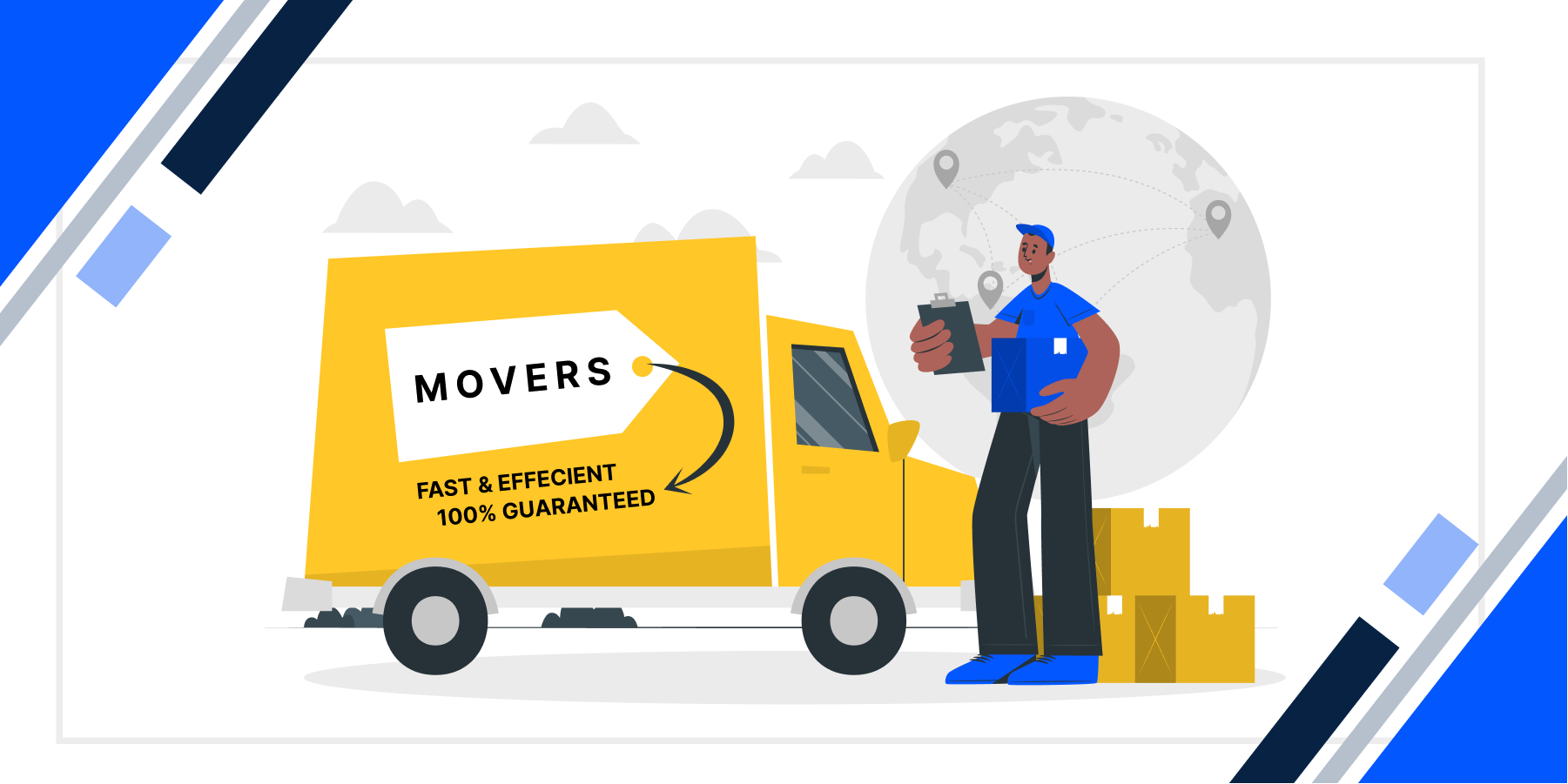
If you’ve got a strong back, a keen sense of organization, and a knack for helping people through stressful times, then starting your own moving company might just be the perfect business for you.
Why?
When times are good, people invest in new houses, businesses require more space to grow, and both cases drive the demand for moving companies up.
Conversely, when times are challenging—like now—both people and businesses will downsize, selling their current homes or buildings to cut costs.
Either way, if you own a moving company, it’s a win-win. This blog will give you all the ins and outs you need to start your own moving company. From business plans to legal requirements, we’ve got you covered from every angle.
Jump to:
-
Is Starting a Moving Company Profitable?
-
The 8-Step Process of Starting Your Own Moving Company
-
1. Decide What Type of Moving Services You Want To Offer
-
2. Put Together a Business Plan
-
3. Fulfill the Legal Requirements of Business Ownership
-
4. Obtain a Business Loan or Other Funding
-
5. Hire Professional Movers
-
6. Build and Launch Your Website
-
7. Set Up Your Online Presence
-
8. Start Attracting Your Ideal Customers
-
-
Seamlessly Run Your Moving Business
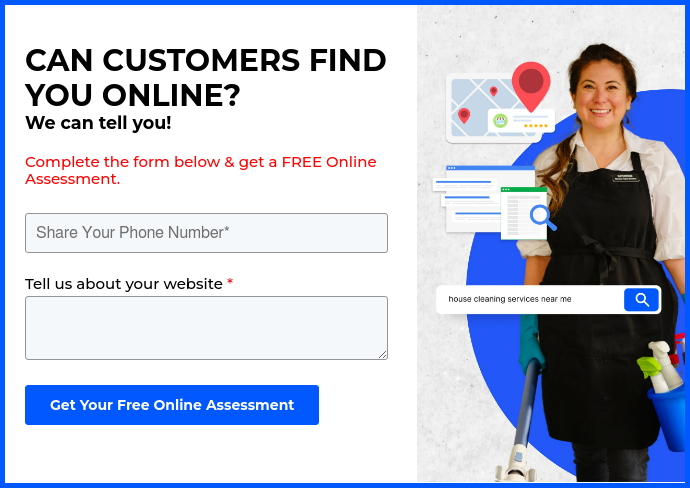
Is Starting a Moving Company Profitable?
Starting your own moving company can be very profitable, depending on factors like your rates or the number of employees you hire. Some estimates put potential profit as high as 40% of revenue, but more conservative estimates put profit margins around 20% (which is still usually high for the average small business venture).
So far this year, nearly 20,000 moving companies are working in the US alone, with the number growing a half percent each year since 2018.
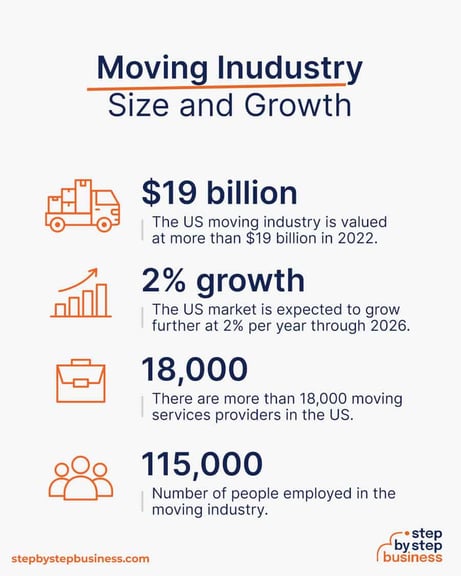 Source: Step By Step Business
Source: Step By Step Business
Don’t let the fear of competition stop you. With the demand for movers extremely high and the industry growing at a rate of 2% per year through 2026—that’s 380 million per year— there’s very little downside to investing in your own moving company.
The 8-Step Process of Starting Your Own Moving Company
Now that you’re excited about starting your own moving company, it’s essential to understand the steps involved in setting up this type of home services business.
`1. Decide What Type of Moving Services You Want To Offer
Do you want to offer local or long-distance moving services? Or both? Think about what types of moves your company can make. Are there any special services that you could offer, such as:
- Loading and unloading
- Packing
- Storage solutions
- Cleaning and organizing the old or new home or both
- Assisting with address changes
- Disconnecting or reconnecting appliances
Decide which ones make the most sense for you and your available resources.
How Far Will You Move Customers?
Determining whether you want to focus on local or long-distance moves might be challenging because each option brings its own set of pluses and minuses. Let’s start by examining the pros and cons of local moves.
Local Move Pros
- You can become an expert in the local area, knowing the best routes and shortcuts.
- You will have a more consistent customer base with which you can build relationships over time.
- You won’t have to worry about long-distance regulations and paperwork.
Local Move Pros
- Limited potential for growth—if you only do local moves, you may not be able to increase profits.
- Your pricing must stay competitive since customers may already know other local companies who offer similar services.
- You won’t have the opportunity to charge higher prices for long-distance moves.
If you’re not sure you want to stay local, then you might want to consider long-distance customers. Here’s a list of benefits and challenges to help you decide.
Long Distance Move Pros
- More opportunities to serve customers who need to move farther away
- Higher prices for longer trips due to increased time and effort required
- Increased potential customer base as people may not have access to local moving companies in their area
Long Distance Move Cons
- Longer travel times require more planning and resources for each job
- Increase in costs associated with higher fuel expenses and other fees
- More liability due to increased time spent on the road transporting customers' belongings
Finally, research what other companies in your area are doing and how far they're willing to go. This can give you an idea of what's realistic and help you set reasonable expectations when promoting your business online.
Will You Pack and Move? Or Just Move?
You'll need to decide whether you'll provide packing services or just move items already packed. For the record, there are a lot of people who love the idea of not having to lift a finger for the entire move, and offering packing services will be attractive. Here's a look at the pros and cons of each option.
Pros of Providing Packing Services
- You can charge more, as it takes extra time and effort to pack things properly
- It gives your customers peace of mind knowing their belongings will be safe during the move
- Customers often prefer to get all their services from one place when they're under a lot of stress (like people usually are during moving) – if you can provide everything they need in a short phone call, they’re more likely to go with you
Cons of Packing for Your Customers
- It requires extra time and labor for you
- You will need to purchase packing materials like boxes, bubble wrap, etc.
- You'll be liable if any items are damaged during the packing process
How Much Stuff Can You Move? Do You Need Vans or Trucks?
The next question to ask yourself is how much stuff you'll be moving and what kind of vehicles you need. If you only transport small items like boxes or furniture, you might not need big vans or trucks.
But you’ll need bigger trucks if you move more oversized items such as appliances or pianos. And remember to factor in any additional cost for fuel and other things. With careful planning and organization, you can decide what kind of vehicles will best suit your needs.
Will You Do Residential and Commercial?
Residential services are for people who are moving from one home to another. Commercial services are for businesses that need help relocating their offices and items.
Think about the areas you want to serve, whether just one city or an entire state. Research the local market and what types of customers may need your help. Consider the type of equipment and resources needed for each service—residential may require fewer supplies than commercial moves.
This is because, for residential moves, you'll need fewer personnel and will be moving less specialized equipment. You can also typically get away with a smaller truck or van for residential jobs than larger trucks needed for commercial jobs.
Consider any additional screening or protocols you may need to take when moving commercial businesses. These steps will help you protect both you and your customers.
For instance, many businesses transport sensitive data and documents when moving commercially. This may require you to get background checks on your employees and check references carefully to comply with data protection laws.
`2. Put Together a Business Plan
A good business plan is key to getting your moving business off to a great start. When setting up your plan, make sure to include the following information:
Business Model, Operations, and Management Details
No business plan is complete without a full breakdown of your proposed business model, operations, and management. Let’s break these down a little further for you:
- A business model outlines how you will make money by providing services to customers.
- Your description of operations outlines how the business's day-to-day activities will work.
- Your business management plan explains who will be responsible for key tasks in running the company.
Having this information in your plan helps ensure you are prepared for success!
Pricing Structure
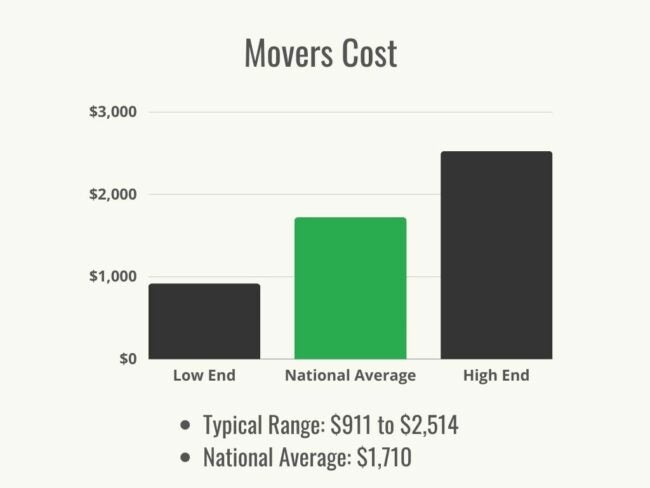 Source: Bob Vila
Source: Bob Vila
When pricing your services, the key is balancing what you need to charge and what customers are willing to pay. Start by researching other moving companies in your area and their rates. This will help you create a starting point for your prices.
Consider factors like time, mileage, number of movers needed, and any special equipment or materials needed when deciding how much to charge. Once you know what competitors are charging, decide if you want to be more competitive or if there’s enough room in the market for higher rates.
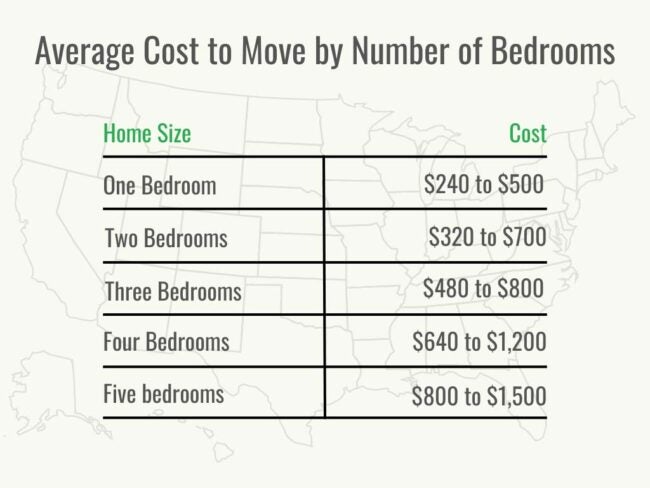 Source: Bob Vila
Source: Bob Vila
Consider offering discounts or packages to shift the perceived value to price ratio in your favor. In addition, discounts help your business grow – if you’re not using them, you’re missing out.
First, offering discounts or packages can help bring in new customers. People will be more likely to choose your moving company if they know a discount is available. This means more people using your services and more money for your business.
Second, offering discounted packages encourages people to buy more from you at once, which also brings in extra revenue. For example, if someone needs three boxes of packing supplies but sees that they can get them all with a package deal for one price instead of buying each box separately—they’re likely to take the deal.
Finally, offering discounts or packages can help you build loyalty with customers. If people know that they’ll save money by using your services, they’re more likely to come back for future moves. In the long run, this means repeat business and more money for your moving company.
Once you have a pricing structure in place, make sure that it is clearly communicated to potential customers.
Target Audiences and Marketing Plan
Your first step in finding your “target market” is to figure out your ideal customers. Who do you want to help with their moving needs? Consider age, location, and budget when deciding who would benefit from your services.
Next, create a marketing plan that fits within your budget. Utilize free resources like social media and word of mouth to spread the word about your business. For more reach, you can also look into paid advertising options such as radio or newspaper ads.
Employees
You'll want enough staff in your company to help load and unload items, drive the truck, and provide customer service. Depending on the size of your business, consider hiring 3-4 people at least. When it comes to employees, look for strong ones who can lift heavy furniture and boxes.
Also, hire someone with excellent customer service skills as they will interact with customers throughout their move. Lastly, make sure all employees have valid driver’s licenses so that they are able to drive. If you’re moving with large trucks, you’ll want to make sure that you have enough CDL drivers to keep your crews busy.
Startup and Overhead Costs
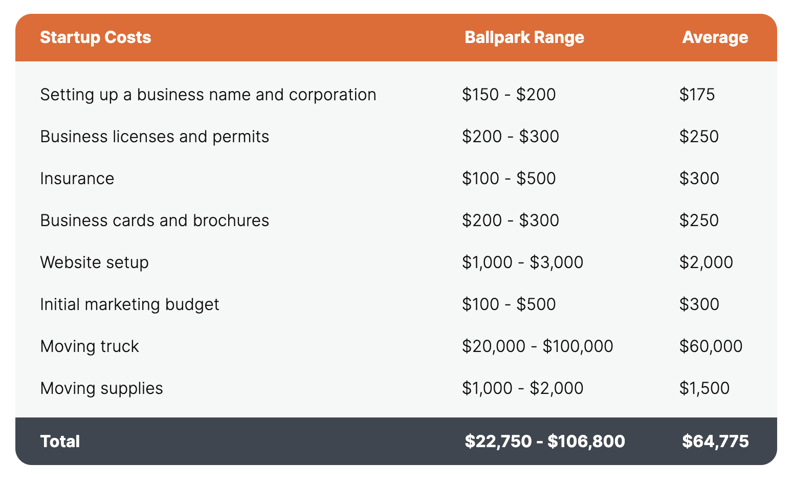 Source: Step By Step Business
Source: Step By Step Business
You'll need to budget for startup costs that range from $20,000 to $100,000. On average, it will cost about $65,000 in upfront expenses.
Some of the biggest costs include purchasing vehicles and equipment such as protective blankets and straps; hiring employees; getting insurance coverage; and finding a storage facility if needed.
Financial Projections
Financial projections will help you estimate your business's cost and potential revenue so that you can make better decisions about how to run it. Here's a list of statements to include:
- Pro Forma statements. These statements help estimate future revenue and expenses so you can plan ahead.
- Break-even analysis. This helps determine when your business will start making money by showing how many units or services must be sold to cover costs.
- Three years of cash flow statements. This shows how much cash flow (movement of money) your business has in three years.
- Income statement. This statement shows how much revenue your company made during a certain period of time and the costs associated with running the business.
- Balance sheet. This statement provides an overview of your company's assets (such as vehicles or equipment) and liabilities (or debts) that need to be paid off over time.
- Financial ratios. Financial ratios help you compare your business performance to industry standards and competitors.
Having accurate financial projections will give you a better understanding of how much money you need to start and run a successful moving company.
`3. Fulfill the Legal Requirements of Business Ownership
Some legal requirements must be fulfilled before you can start your new business. Here’s what you need to do:
- Get an Employer Identification Number (EIN) from the IRS
- Register your business with the state and local governments
- Obtain necessary permits and licenses for your industry, both state and federally if you are crossing state lines
- Open a business bank account
- Choose a business structure (sole proprietorship, partnership, LLC, etc.)
- Get business insurance
- Get a "doing business as" (DBA) name so people can identify your business and ensure it isn't confused with someone else's
`4. Obtain a Business Loan or Other Funding
There are a few ways you can find the money to start setting up your new moving business:
- Get a business loan. Look into getting a business loan from banks or other lenders. Depending on expenses, a credit card with a high credit limit may be all you need.
- Government grants. See if you qualify for any government grants to help fund your moving company.
- Loans with the SBA. Check out Small Business Administration (SBA) loans to help start up your moving company.
- Crowdfunding. Research crowdfunding options like Kickstarter or GoFundMe to raise money for starting your business.
- Friends and family. Ask friends and family for donations or investments in exchange for business shares.
Once you’ve sorted out funding, a business credit card is essential in helping you keep track of business expenses. Not to mention, it keeps your personal finances separate. And if your personal credit score is above 700, you’ll likely qualify for 0% promotional interest for your first 6-18 months.
With a business credit card, you can earn rewards like cash back or points when you make purchases related to your moving company. This can help save money on supplies and other costs associated with running the business.
`5. Hire Professional Movers
Hiring professional movers to work for your moving company is a great way to ensure that you are providing quality service. Experienced movers know how to safely and efficiently move furniture, boxes, and other items from one place to another. They can do it quickly and carefully, saving you time and money in the long run.
`6. Build and Launch Your Website
Having a website is very important when starting your own moving company. It's the first impression people have of you, so it needs to look professional and be easy to navigate. You can either build the website yourself or use software that makes it easier.
If you decide to build it yourself, there are many resources available online such as tutorials and templates that can help you create a great looking website with ease. However, if you don't want to take the time or effort, using software like GoSite's website service is an option too.
`7. Set Up Your Online Presence
Three quarters of small business owners say that having an active online presence helps them gain more customers. Here’s how.

`Google Business is a free listing service provided by Google. It helps customers find your moving company when they search online. Listing your business on it can help increase visibility and make it easier for potential customers to contact you.
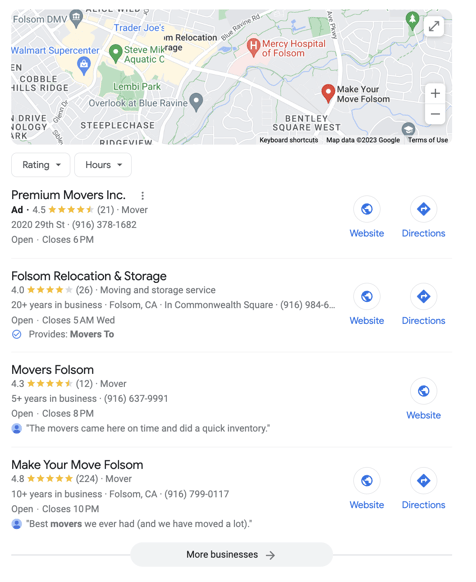 Source: Google
Source: Google
Creating a Facebook page for your moving business is easy! All you need to do is create an account, if you don't already have one. Then go to "Create Page" and enter the details of your company: name, logo, description and contact information.
You can start posting updates about your services or any other news that might be relevant to potential customers. You can also create ads on Facebook to reach more people in the area you serve, building customer trust and loyalty.
Website
As previously mentioned (but worth mentioning again), a website is an absolute must for your new business. Without it, you won't be able to reach potential customers. Your website should include information about your services and availability, so people know what you offer and when they can reach you.
Make sure you also add contact information for potential customers to get in touch with questions or requests.
ODJ Apps
On-demand job (ODJ) apps are a great way to find customers for your moving company. These apps allow you to list your business, so people can easily search for and book services through their mobile devices whenever needed.
Customers can see exactly what services you offer and how much they cost and even read reviews from previous customers before booking. This makes it easier than ever for people to find the moving company that best fits their needs. Plus, with the convenience of on-demand home services, more people will likely be interested in trying out your business!
Other Online Directory Listings
Aside from the heavy hitters like Google and Facebook, you can also list your business on other online directories. Consider sites like Angi, Thumbtack, and HomeAdvisor. You can even create accounts on social media sites like Twitter, Instagram, and TikTok to help spread the word about your moving services!
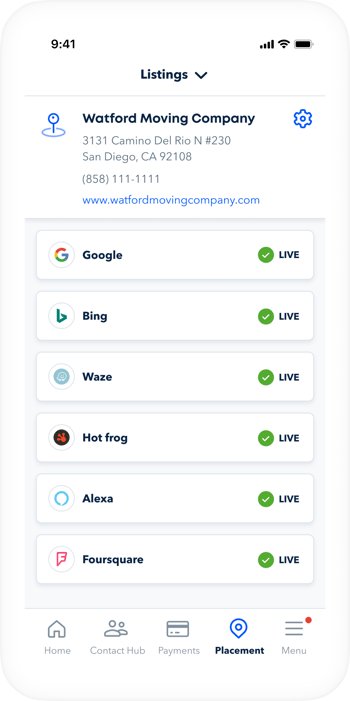
8. Start Attracting Your Ideal Customers
Now that you've identified your ideal customers, it's time to start attracting them. You already know what services they need and where to find them. You've also established your online presence so that you’re easy to find.
The final way to attract clients is word-of-mouth referrals and reviews from family and friends who can spread the word about your business in their local area or online networks. Ask for recommendations from people you know, then make sure you thank those who help by offering discounts or freebies!
Seamlessly Run Your Moving Business
Starting your own moving business might seem like it's out of your reach, but it's actually not that hard! All you need to get started is a truck, some moving supplies, and the right attitude.
By doing your research, getting all of the necessary permits and licenses, and creating an effective business plan, you can have your own successful moving company in no time. The benefits of running your own business are numerous—from financial freedom to being able to make decisions about how things are run.
So go for it. Start planning today for a brighter tomorrow as a moving business entrepreneur!
%20(1)%20(1).png?width=340&name=Group%2012%20(2)%20(1)%20(1).png)


